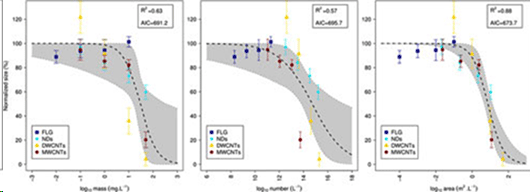|
NOVIDADES
In the fields of toxicology and ecotoxicology, doses are commonly expressed in weight concentration for non-soluble compounds because this is very convenient experimentally. However, when it comes to nanoparticles, the weight of the nanomaterial is not a relevant parameter, especially when it is required to compare different kinds of nanoparticles – such as carbon or metals for example – because their density is very different. "The two other ways of expressing the dose are the number of particles and the total surface they express," Dr. Emmanuel Flahaut, CNRS Research Director at the Centre Interuniversitaire de Recherche et d'Ingénierie des Matériaux (CIRIMAT), Université Paul Sabatier in Toulouse, tells Nanowerk. "Both parameter are a priori much more relevant in terms of biological impact. However, our results show that surface area leads to the best correlation when it comes to the comparison of different nanoparticles. We advise to use this metric for future work in the field, which will allow a much more relevant comparison of the results from one group to another. "In new work, Flahaut and his collaborators show that that the usual approach based on mass concentrations fails to compare the toxicities of different engineered carbon nanoparticles (C-NPs). They report their findings in the April 28, 2016 online edition of Nano Letters ("Surface Area of Carbon Nanoparticles: A Dose Metric for a More Realistic Ecotoxicological Assessment"). The most significant result of this study is that the researchers demonstrate that the surface area can be used as a relevant metric to compare the toxicity of different kinds of carbon nanoparticles, but more importantly, for the first time that it can even a priori also be used as a criterion for predicting the toxicity – at least in the team's experimental conditions – of carbon nanoparticles, ranging from 0D to 2D. For this study, the scientists used four different types of C-NPs: few-layer graphene (FLG, 2D); nanodiamonds (NDs, 0D); double-walled carbon nanotubes (DWCNTs, 1D); and multi-walled carbon nanotubes (MWCNTs, 1D). They monitored and compared the inhibition of Xenopus laevis larvae growth after in vivo exposure to all those different carbon nanoparticles for 12 days using different dose metrics.  Growth inhibition in X. laevis larvae after a 12 day exposure to FLG, NDs, DWCNTs, and MWCNTs. Normalized size (%) is plotted vs the base-10 logarithms of three different metrics: mass concentration (mg•L–1), number concentration (L–1), and surface area concentration (m2•L–1). Black dashed lines represent nonlinear regression model predictions, and shaded areas are 95% confidence intervals (CIs) on these. The 95% CIs on the mean sizes, which were computed from the experimental assays, are represented as vertical error bars (Reprinted with permission by American Chemical Society).
"A full characterization of engineered nanoparticles must be provided in every ecotoxicological study in order to allow the toxicity comparison of C-NPs, which should be done on the basis of surface area instead of weight concentration as it is usually the case," says Flahaut. "The use of this metric would help in the definition of a more realistic risk assessment strategy for carbon-based nanoparticles in the aquatic environment. "The idea to investigate different metrics to express the dose-response results was not new in the field. However, this is the first time a clear demonstration is given with the comparison of different carbon nanoparticles with different geometries, evidencing that this result can be generalized. "The motivation for this study came from our earlier work dealing with the environmental impact of different kinds of carbon nanotubes when we realized that it was impossible to really compare our own results based on weight concentration," Flahaut notes. (see for instance: 2D Materials, "Examining the impact of multi-layer graphene using cellular and amphibian models" and Toxicological & Environmental Chemistry, "International standardized procedures for in vivo evaluation of multi-walled carbon nanotube toxicity in water"). "We hope it will allow better relevance for the comparison of results published by different groups if researchers now make the required characterisation in order to express their results vs surface instead of weight," says Flahaut. These results may also be useful for researchers working for example in the field of nanocomposite materials, because interfaces between a nano-filler and the matrix always play a crucial role. Taking into account the surface of interaction between the matrix and the load instead of only thinking in terms of weight or volume ratio may lead to interesting approaches for data analysis. This approach may help to re-analyze earlier work and gives indications for further research in the field. Flahaut's team, in collaboration with ECOLAB, for instance, is currently investigating the influence of surface functionalization on ecotoxicity, because modifying the interface with water should also have very important consequences. The interaction between nanoparticles and cells or tissues on a larger scale are largely controlled by what happens at the interface, i.e. at the surfaces. However, the exact nature of this surface is rather difficult to assess because many biomolecules such as proteins but also salts present in water tend to accumulate there very quickly and often in a rather dynamic way. "We are now working on the influence of surface functionalization on ecotoxicity in order to improve our understanding of what is taking place at the interface and to check if our conclusions are truly general or if some limitations apply," Flahaut describes the team's current work. Michael Berger, Nanowerk, Posted May 24, 2016. |
|||||||||||||||||||||||||